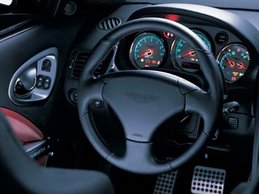 2006 Cadillac XLR-V - With its XLR-V, Cadillac puts a player in among the SL55 AMGs and Jaguar XKRs of the world — cars with performance and pedigree to spare. So how does the XLR-V match up, this low-slung, high-end pretender to the thrones of Europe?
2006 Cadillac XLR-V - With its XLR-V, Cadillac puts a player in among the SL55 AMGs and Jaguar XKRs of the world — cars with performance and pedigree to spare. So how does the XLR-V match up, this low-slung, high-end pretender to the thrones of Europe?The Northstar is also endowed with desirable versatility, able to purr around at lower engine speeds as befits a luxury marque, then snarl to the redline with almost shocking ferocity. Part of this Jekyll-and-Hyde act is due to a muffler that suppresses low-rev noise levels and then switches to a more free-flowing mode at higher speeds when a vacuum-operated valve opens, allowing the exhaust gases a more direct path to the atmosphere.
The engine block is a unique casting that provides improved coolant flow and has a new oil gallery to supply under-piston cooling jets. Lower-compression cast-alloy pistons necessitated a rebalancing of the crankshaft, and the accessory drive required a redesign and a new, wider three-sheave pulley to power the blower. That’s no small issue, since the supercharger soaks up nearly 80 horsepower at maximum speed.
All that torque just about precludes the need for a downshift in most scenarios, but the intelligent 6L80 six-speed automatic transmission will probably hand you one (or two) anyway when you squeeze the throttle. This rear-mounted six-speed provides almost intuitive response to a driver’s inputs with Caddy’s performance shift algorithm, which refrains from shifting up on a trailing throttle when cornering. This action also informs the magnetorheological shocks to switch to sportier settings.
In supercharged form, the XLR-V wears 19-inch wheels and rubber, but with nothing like the width found on i
 ts Corvette cousins. The rear tires are 255/40R-19 Pirelli run-flats. (The Vette runs 285s on “normal” models and 325s on the Z06.) The result is a car that can be used as an everyday commuter with far less drama and inconvenience than can its bow-tie-badged brothers.
ts Corvette cousins. The rear tires are 255/40R-19 Pirelli run-flats. (The Vette runs 285s on “normal” models and 325s on the Z06.) The result is a car that can be used as an everyday commuter with far less drama and inconvenience than can its bow-tie-badged brothers.Noise levels are low enough — some road roar aside — to allow full enjoyment of the nine-speaker Bose stereo with the hardtop in place. The Caddy has a navigation system, dual-zone climate controls, fully powered seats, keyless door opening and engine operation, and the tactile delights of French-stitched leather coverings throughout the interior. These improve the ambiance considerably. The XLR always suffered somewhat from the modern angularity of its design. The V-series textural additions soften the overall effect.
Cadillac employs GM’s magnetic steering mechanism to vary effort, and although the XLR-V’s wheel feels a little leaden at low speeds, it improves to a reasonable heft in the driver’s hands as speed rises. But the wheel never transmits the stimulating feedback you get in the best sports cars. To be fair, though, the XLR-V’s likely competitors in this market — the BMW 650i, the Mercedes SL55 AMG, the Lexus SC430 — have similarly inert steering mechanisms.
This is not a serious problem for most drivers (we leave the system on in normal driving situations, too), and it’s a positive benefit for the average owner. Anoth
 er safety technology — this one exclusive to the V-series — is a system that swivels the headlights in corners to improve the illuminated field of vision. Try this before you deride it as technology for its own sake; trust us, it’s advantageous to see where you’re going.
er safety technology — this one exclusive to the V-series — is a system that swivels the headlights in corners to improve the illuminated field of vision. Try this before you deride it as technology for its own sake; trust us, it’s advantageous to see where you’re going.As high-performance roadsters go, the XLR-V is quite well-suited to the quotidian requirements of your less-extreme motorist. There’s no super-low chin spoiler to mash on parking curbs. There are no limbo antics necessary to get in and out. The car has all the creature comforts technology can provide, and its unique mesh grille, supercharged badge, and four shiny tailpipes tell everyone this Cadillac is a cut above.













No comments:
Post a Comment